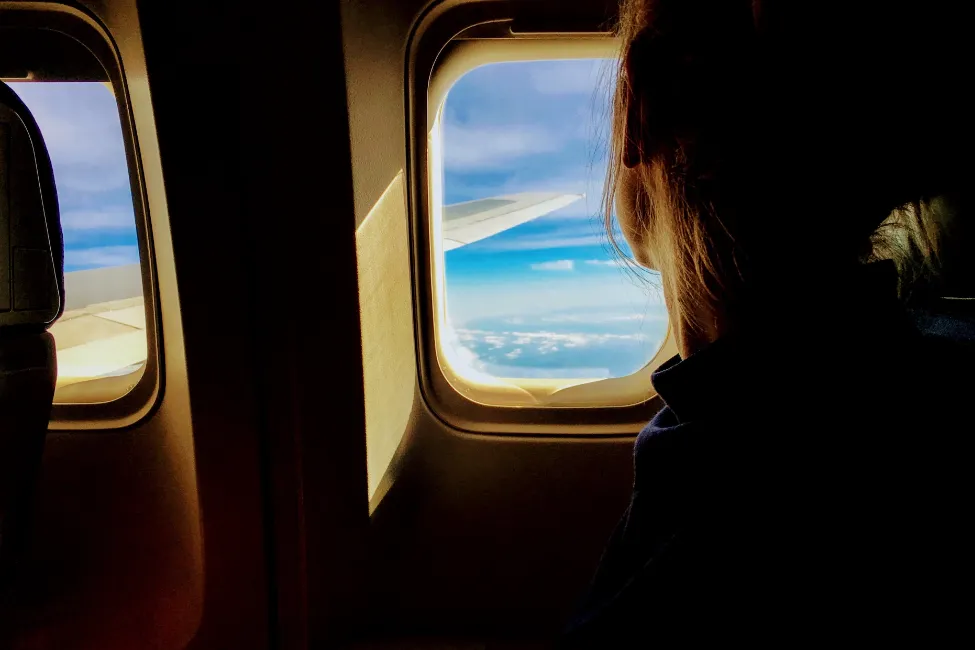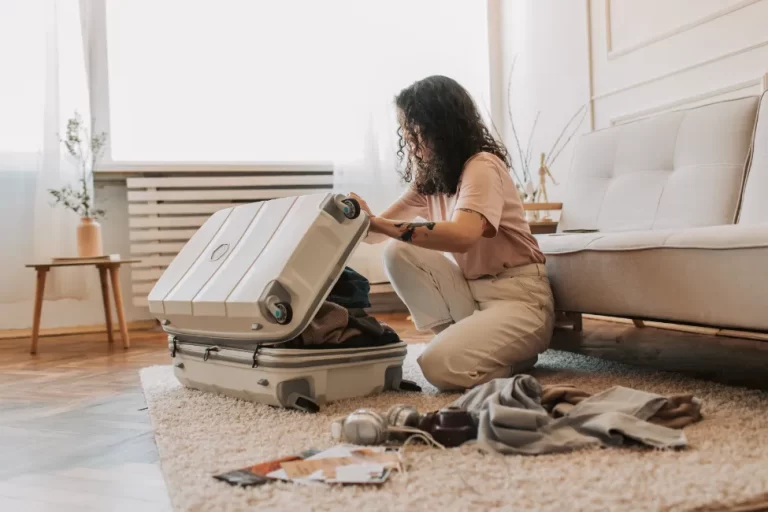What To Bring on a Plane + Essential Carry-On Does and Don’ts

Are you about to go on a plane trip and are not sure what to bring with you?
Do not worry, because I’m here to help. In this article, I will give you a list of what to bring on a plane and what you should leave in your checked bag or at home.
We’ll unpack what to take in your carry-on bag, what to leave in your checked luggage, and how to avoid bumping into issues at the airport security lines.
Follow these guidelines and you will have everything you need without having to worry about it.
TL;DR – give me a checklist of ideas
- Your boarding pass (electronic or printed)
- Your ID (driver’s license or passport)
- Your itinerary (especially if you have a layover)
- A face mask (if you’re feeling under the weather or to protect yourself from your sneezing seat neighbor)
- Hand sanitizer
- Wet wipes
- Tissues
- Essential medications (especially if you have a prescription)
- Bandaids
- Water bottle
- Laptop or tablet
- Headphones
- Pre-downloaded music
- Pre-downloaded podcasts
- Books & magazines
- Games (a great option if traveling with kids)
- Sudoku or crossword puzzles
- Neck pillow/ travel pillow
- Eye mask
- Travel blanket
- Compression socks
- Adapters for your electronics
- A change of clothes in case your luggage is lost/delayed
- Any necessary documents for entry into a new country
- Any currency needed for expenses at your destination
- A snack (if you get munchy on long flights like me!)
Want to learn more? Let’s jump in!
What to bring on a plane?
When packing for a plane, it is important to make sure that you bring the items you need while following the airline’s guidelines.
In your carry-on bag
If I’m bringing a carry-on, I try to pack only essential items such as clothing and toiletries, like a toothbrush and travel toothpaste. At a minimum, I like to pack one change of clothes and some pajamas in case for some reason my checked luggage gets lost. I store all my toiletries in a quart-sized bag to prevent any spills.
Although I do often bring carry-on luggage on the plane, in my mind, I treat it like a checked bag. I don’t want to bother pulling it out from the overhead bin to get my water bottle.
This is where the personal item bag comes in.
In your personal item bag
You may have noticed that airlines allow you to bring one carry-on and a small “personal item.” This could be a purse, small backpack, or tote bag.
Your “personal item” is where you’ll want to store everything you’ll need during your flight.
For travel
There are a few essential items you’ll want to have on hand when traveling. These include:
- Your boarding pass (electronic or printed)
- Your ID (driver’s license or passport)
- Your itinerary (especially if you have a layover)
If you have these things, even if you forget everything else, trust me, you’ll be ok! Pretty much everything else you can purchase, but your ID and boarding pass (and knowing when and where you’re traveling) are absolutely essential.
For health
We all know travel has gotten a little bit more stressful in recent years due to Covid. Although many health precautions are no longer required, it can be a good idea to bring a few items to help you stay healthy while traveling.
The last thing you want is to arrive at your vacation with a sore throat!
A few items I recommend are:
- A face mask (if you’re feeling under the weather or to protect yourself from your sneezing seat neighbor)
- Hand sanitizer
- Wet wipes
- Tissues
- Essential medications (especially if you have a prescription)
- Bandaids
- Water bottle
I want to pause on the last point – the water bottle. As you probably know, TSA doesn’t allow you to bring large amounts of liquids through airport security,
But dehydration is a very common occurrence during air travel.
That’s why I bring an empty water bottle with me through security so that I can fill it up after at a water fountain. You can also always ask the flight attendant to fill it up for you on the plane.
Staying hydrated is essential for healthy travel!
For entertainment
Nowadays, many airplanes have personal in-flight entertainment systems at every seat. But this is not a guarantee! When I travel, I like to be prepared with something to keep me busy on the flight.
Sometimes that just means my laptop so I can do some writing on the plane. Other times it means pre-downloading some podcasts.
Here are some ideas:
- Laptop or tablet
- Headphones
- Pre-downloaded music
- Pre-downloaded podcasts
- Books & magazines
- Games (a great option if traveling with kids)
- Sudoku or crossword puzzles
If you are packing electronics like laptops or tablets, remember to charge them before leaving home and also bring along their chargers in your carry-on bag. I also like to bring a fully charged power bank.
Again, many planes have USB charging outlets, but not all. I like to play it safe and bring my lipstick-sized portable charger just in case.
For comfort
Of course, all of us want to be comfortable while traveling. Here are a few ideas of things you can bring with you on the plane to elevate your travel experience and arrive a little bit more rested
- Neck pillow/ travel pillow
- Eye mask
- Travel blanket
- Compression socks
When traveling internationally
If you have a long-haul flight, there are a few additional items you might need to bring.
These may include:
- Adapters for your electronics
- A change of clothes in case your luggage is lost/delayed
- Any necessary documents for entry into a new country
- Any currency needed for expenses at your destination
- A snack (if you get munchy on long flights like me!)
Now that you know what to bring on an airplane, let’s look at what it’s best to leave behind.
What not to bring on a plane
It’s important to be mindful of what you bring as some items may not be allowed on board due to safety and security reasons.
Here are some items to note:
- Liquids over 100ml or 3.4 oz (all containers must fit in a single 1-liter bag)
- Disposable and electric razors
- Sharp objects (knives, swords, box cutters, knitting needles, and tools)
- Explosive items (fireworks, flammable liquids, firearms, and ammunition)
- Alcoholic beverages over 140 proof or 70% alcohol by volume
- CBD products
I recommend carefully reading through the list of items when purchasing your airline ticket or check-in for your flight. You can also check out this list from the TSA.
For international travel
If traveling internationally, remember that most countries have restrictions on certain items that can enter their borders so be sure to check if there are any specific regulations pertaining to what you can bring into another country before you pack it into your luggage.
In addition to the carry-on bag and personal item mentioned earlier, many airlines allow travelers one checked bag weighing up to 50 lbs for international flights; however, double-check with your airline regarding their specific policies regarding weight limits prior to departing.
How to pack your carry-on bag
Have you ever wondered what the right way to pack a suitcase is?
Packing a carry-on bag for a trip can be a challenge. To make sure that your carry-on bag has everything you need and is not too heavy, it’s important to plan ahead and pack smart.
To begin with, take the time to check the airline limits for carry-on luggage size and weight. Most airlines allow one piece of carry-on at no extra cost but have restrictions on dimensions and weight, so it is best to be aware of these before packing anything.
I love using compression packing cubes to keep maximize space in my luggage and keep everything organized and in place. This makes it a lot easier to quickly pull out the needed items without rummaging through all your clothes and other belonging.
It is also good practice to keep all documents easily accessible such as passport, tickets, and boarding pass in an outside pocket or pouch of the bag so they can be accessed quickly when necessary.
When choosing what items to pack in your carry-on bag, prioritize items that are essential during the flight such as medication, headphones, a wallet/purse with money/credit cards, and phone chargers.
Electronics like laptops should also be packed in their own bags to avoid damage caused by other items moving around inside the bag during transit.
If you want to take snacks and drinks on board, then opt for food with minimal packaging and liquid containers no larger than 100ml each which meet airline regulations.
Additionally, if you’re traveling abroad ensure you check your destination’s customs regulations for what items are permitted into the country before packing anything away in your carry-on luggage.
By following these tips, packing your carry-on luggage becomes easier as you are able to maximize space inside the bag while still adhering to airline restrictions.
Always give yourself enough time before departure so that all of your essentials go into your carry-on luggage without any last-minute rush or panic – this way you can enjoy stress-free travel!
Tips for traveling with a carry-on bag only
If you decided to travel light, it’s important to be smart about how you pack your carry-on bags. After all, space is very limited. Here are a few tips to help you.
1. Research your destination
Before deciding to commit to traveling with only a carry-on, research the destination to ensure you’re packing the right items and that all of your essentials can fit in one bag.
Think about the climate and weather patterns of your destination and plan accordingly with lightweight pieces that are easily layered if necessary. If you are planning on doing activities such as swimming, snorkeling, or hiking, make sure you have appropriate clothing and shoes that won’t take up too much space in your bag.
2. Invest in quality luggage
When opting for a carry-on-only style of travel, it’s important to choose a quality piece of luggage that is durable, easy to maneuver, and not too heavy when packed.
Look for features such as wheels that rotate 360 degrees for increased ease of movement, compartments for organizing items and keeping them secure, as well as an expandable zipper for extra space if needed.
3. Take advantage of organizational accessories
Utilizing a variety of organizational accessories such as packing cubes and compression sacks will help maximize the space in your bag and keep items organized throughout your travels.
Additionally, bringing along reusable grocery bags or collapsible totes can also be beneficial for carrying additional items during your trip without having to purchase new items once you arrive at your destination.
4. Roll clothes instead of folding them
One great way to save space when packing is by rolling clothes instead of folding them; this helps garments fit more snugly into small spaces while reducing wrinkles at the same time!
Place heavier items like jeans at the bottom of the suitcase with lighter items on top so they won’t be crushed underneath heavier pieces.
5. Wear bulky items on flights
For long-haul flights where every inch counts in terms of valuable storage space in your carry-on bag, consider wearing any bulkier items like coats or jackets while flying so they don’t take up unnecessary room in the suitcase.
Wrapping up
Overall when preparing for a flight it is important not only to know what items are necessary but also which ones are allowable by the chosen airline, ultimately allowing for an easy travel experience!
By following these tips, packing your carry-on luggage becomes easier as you are able to maximize space inside the bag while still adhering to airline restrictions.
Give yourself enough time before departure so that all of your essentials go into your carry-on without any last-minute rush or panic – this way you can enjoy stress-free travel!





